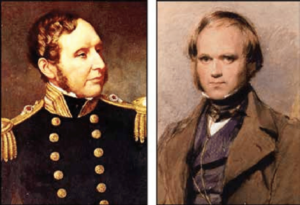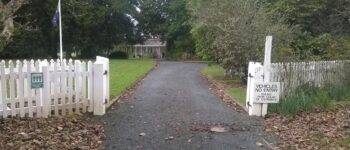1835: Darwinian’s New Zealand Christmas
January 17, 2022
By AHNZ

“December 21st [1835] Early in the morning we entered the Bay of Islands, and being becalmed for some hours near the mouth, we did not reach the anchorage till the middle of the day.” So began a Christmas visit of just 9 days which was a dearly bought by the HMS Beagle considering the many extra days at sea spent in visiting. Captain Robert FitzRoy as well as Charles Darwin wrote books detailing the 1835: The Voyage of the Beagle and here are some highlights from Darwin’s.
Arriving at the Bay of Islands, Darwin finds all very still and quiet and green with fern. Three whaling ships are anchored there and nobody rushes out in excitement to greet the becalmed Beagle as at other places. An “…air of extreme quietness reigned over the whole district.” In the evening, the company visit the little Missionary village of Pihea. Apart from this there are a further 2-300 English families living and working at the Bay in very neat, whitewashed, cottages. But, “The hovels of the natives are so diminutive and paltry.”
December 22nd Darwin takes a walk and observes that almost every hill a is a former fort (‘pa’) site with steps and midden to prove it. Firearms have changed warfare and now they are derelict. He learns that the modern Maori fort has inward-facing partitions so a warlord’s warriors can never be demoralised by knowing if their side is being killed. A Maori device to promote necessary ignorance in service of the chief! In this way the Maori pa is not only constructed to combat the foe but equally to combat the chief’s own tribesmen. It reminds me of how officers beat ANZAC soldiers with clubs to make them fight against their own will. Or, how a firing squad shoots only one live round and the rest blanks so soldier doing the distasteful deed knows what is going on and if he is an executioner. Macabre Human Resource Department techniques!
“The Rev. W. Williams, who gave me this account, added, that in one Pas he had noticed spurs or buttresses projecting on the inner and protected side of the mound of earth. On asking the chief the use of them, he replied, that if two or three of his men were shot, their neighbours would not see the bodies, and so be discouraged.” – Darwin
“Their conduct on first seeing a ship, as described by Captain Cook, strongly illustrates this: the act of throwing volleys of stones at so great and novel an object, and their defiance of “Come on shore and we will kill and eat you all,” shows uncommon boldness. This warlike spirit is evident in many of their customs, and even in their smallest actions. If a New Zealander is struck, although but in joke, the blow must be returned and of this I saw an instance with one of our officers.” – ibid
“FitzRoy took Darwin along: To keep him company, to keep him sane against a propensity for men in the family and the role to off themselves.” – 1835: The Voyage of the Beagle
 Note Darwin’s observation about the Maoris as having a great sensitivity to slight. This Personality Culture must repay every perceived hurt in strict observance of their dominance hierarchy. They were an Honour Culture people. Darwin recounts that a tribe went to war without any other cause than that their gunpowder barrel was getting old and ‘waste not want not’.
Note Darwin’s observation about the Maoris as having a great sensitivity to slight. This Personality Culture must repay every perceived hurt in strict observance of their dominance hierarchy. They were an Honour Culture people. Darwin recounts that a tribe went to war without any other cause than that their gunpowder barrel was getting old and ‘waste not want not’.
Darwin is told that Hongi Hika is dedicated to violence and revenge by childhood oath however I learned from The Killing Fields of Auckland (Kiwi Codger 2021) a motive I had not considered. Like Darwin I had not thought Hongi Hika really needed a reason to engage in vast wars. It was just a larger scale of business as usual. Kill or be killed. Amass weapons and use them…Here’s a more strategic reason from this video though. Hika killed a giant before it grew. If the Auckland people had gained a missionary station and the commerce and arms that follow they would have grown in power to more than rival Hika’s and become a very great threat. Perhaps he knew it and made the pre-emptive strike.
Darwin would be all the more horrified to know what was taking place meanwhile at the Chatham Islands- the genocide of the Moriori of November/December of the same year. Though there was no British Government in New Zealand or the Chathams in 1835 our Labour 6.0 government in 2021 nevertheless paid out some $18,000,000 compensation for not having saved the Moriori. It’s as if Captain Fitzroy and Darwin were supposed to have known about the carnage and acted to stop it and in not interfering this way are at fault. Go figure.
Darwin and his captain mingled at Kororareka village, making some interesting observations about facial mutilation: “No doubt the extraordinary manner in which tattooing is here practised, gives a disagreeable expression to their countenances. The complicated but symmetrical figures covering the whole face, puzzle and mislead an unaccustomed eye: it is moreover probable, that the deep incisions, by destroying the play of the superficial muscles, give an air of rigid inflexibility.” The old Maori tattoo style apparently involved de-animating one’s face surgically all the better to be unable to express thoughts and feelings. It’s a empathy-killer but it was on its way out. Conrad Fristedt observed in the 1890s: ‘You can see that old Maori men have their faces so full of all kinds of dark blue rings and curls that there is not enough flat face to lay a finger tip upon.’
“But their persons and houses are filthily dirty and offensive: the idea of washing either their bodies or their clothes never seems to enter their heads.” Of course, Cultural Hygiene is some firmware not passed on to all Maoris even today. Indeed, the Government actively gets in the way of that happening.
 December 23rd, Waimate Mission Station visit. Darwin refers to James Busby as “Mr. Bushby” which further backs my theory that the man had a Sean Connery accent. A chief offers himself as Darwin’s guide but refuses to be a porter as well. The chief brings a slave for that and Darwin makes an observation worthy of Thornstein Veblen: “These feelings of pride are beginning to wear away; but formerly a leading man would sooner have died, than undergone the indignity of carrying the smallest burden.” Darwin also meets a native who has such a guilty savagery about him that he is reminded of a macabre woodcut print by Moritz Retzsch of a murderer who throws another man into an iron furnace in obedience to his master. His impression was right, this Maori was such a man.
December 23rd, Waimate Mission Station visit. Darwin refers to James Busby as “Mr. Bushby” which further backs my theory that the man had a Sean Connery accent. A chief offers himself as Darwin’s guide but refuses to be a porter as well. The chief brings a slave for that and Darwin makes an observation worthy of Thornstein Veblen: “These feelings of pride are beginning to wear away; but formerly a leading man would sooner have died, than undergone the indignity of carrying the smallest burden.” Darwin also meets a native who has such a guilty savagery about him that he is reminded of a macabre woodcut print by Moritz Retzsch of a murderer who throws another man into an iron furnace in obedience to his master. His impression was right, this Maori was such a man.
Darwin observes the Maori custom of rubbing noses and, in particular, that it is an institution with not regard to rank. Even a slave, who a chief could command or kill at a whim, in equal when it comes to this rite and who gets to perform it on who or in what order.
At Waimate Mission Mr Darwin was impressed to find a slice of home, civilised England. But most of all he was stirred by what it meant for the New Zealanders. Waimate, he recognised, was the cradle of civilisation for the Maoris: “When I looked at this whole scene, I thought it admirable…high hopes thus inspired for the future progress of this fine island.” The New Zealanders were being taught Christianity, agriculture, health, commerce, trades, and even cricket.
December 24th, Darwin increasingly impressed with the company he is in at Waimate.
December 25th, Christmas at Pahia
December 26th, Excursion to Waiomio. Observation of funeral rites including the self-mutilation mourning ritual.
December 30th, Left New Zealand behind on the evening tide. Darwin writes, “I believe we were all glad to leave New Zealand. It is not a pleasant place. Amongst the natives there is absent that charming simplicity which is found in Tahiti; and the greater part of the English are the very refuse of society.” And, “It was melancholy at New Zealand to hear the fine energetic natives saying that they knew the land was doomed to pass from their children.”
New Zealand in 1835 was not a pleasant place, especially not to a well-connected English gentleman and scholar whose profession and future were situated at home in Britain. Maori culture was coming, kicking and screaming, out of the neolithic stone age into modern civilisation. Apart from the culture shock of meeting the outside world the Maoris were for the first time also meeting each other. Contrary to Hongi Hika being styled as ‘King of New Zealand’, Darwin was right to say Maoris were “republicans in the most absolute sense” and accustomed to making cannibalistic war on one another. The Musket Wars had made Maori life a hard scramble to accumulate trade items and the weapons they purchased or else perish which placed more refined skills and culture generations into the rear-view if not lost completely. Maoris would extinguish themselves completely unless they could find a new social system that would allow them to live without conflict but that’s a very hard transition to make. Darwin did not envy the Missionary men or James Busby who were determined to be the midwives of the new nation forming up. Though Charles Darwin had 10 children I assume he recused himself from the birthing rooms every time as well, probably with the excuse of some new bugs to peruse.
Over the remaining years of the 1830s New Zealand was reforged in a very ‘unpleasant’ process indeed, emerging in self-made towns resembling the TV show Deadwood (2003.) The Slave Culture tantruming discourse Darwin and Busby put up with, and Henry Williams, gave over to a new Honor Culture era. For example, the Kororareka Association (1838,) Johnny Jones’ (1835) whaling settler empire, and King of the Coromandel William Webster (‘King of Waiou’ (1836)) were all ‘two-fisted trailblazers’. Not Darwin’s cup of tea (with Wedgewood service, of course) at all. Not until the 1840s (Grey Dignity Culture Era) would New Zealand begin to resemble a place Darwin could long tolerate. So I don’t take his 1835 estimate as a condemnation of New Zealand so much as the understandable unsuitability of this country to one of the greatest Western minds in history.
—
Ref. The Voyage of the Beagle, Charles Darwin (1839); The Project Gutenberg
Ref. Pa Forskningsfard , Fristedt (1891); University of Toronto, the Internet Archive
Image ref. Waimate North Mission house (1832); AHNZ Archives (2019)
 Like Comment Share
Like Comment Share





